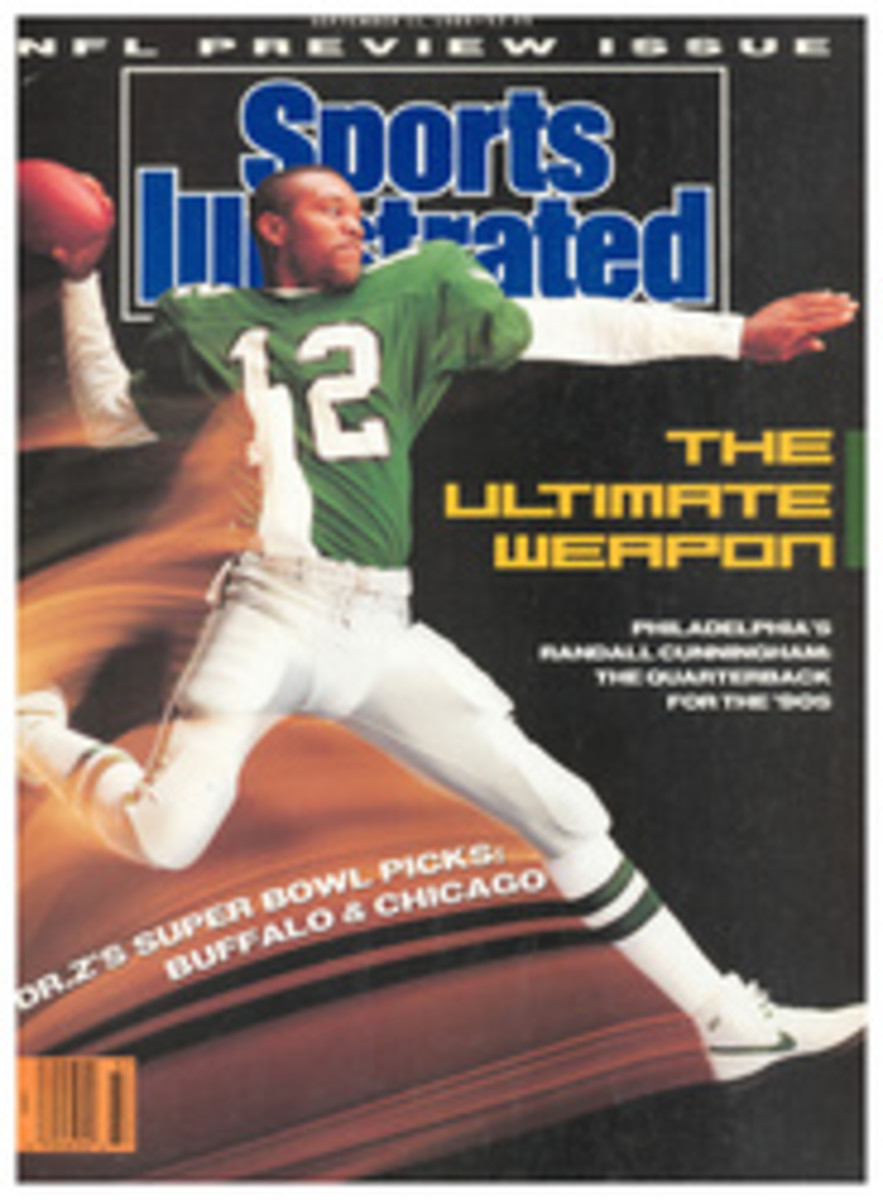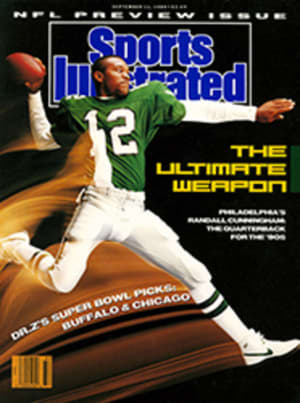
POLAR BEAR SAFARIS: THE HOTTEST THING UP NORTH
At the edge of the shore ice, where Hudson Bay's cold waters move sluggishly beneath a bank of gray fog, a big male polar bear ambles into view. From a distance he seems little more than a harmless hummock of snow that somehow moves. But at the sight of this lord of the Arctic, the eight photographers watching from a Tundra Buggy on a Cape Churchill ridge suddenly develop a shortness of breath. They are transfixed by bear fever.
Tundra Buggy driver and guide Len Smith remains unmoved. A resident of Churchill, Manitoba, he has lived too long among the great white bears to be awed by them. He opens a window and then a can of sardines. The oily odor wafts bearward. Smith knows that polar bears can smell food from a distance of 28 miles. At a mere 300 yards these hors d'oeuvres are irresistible.
The bear's long, Roman nose rises. His head swivels toward the buggy as unerringly as the needle on a compass. He has the scent.
But sardines are strange fare. Plopping his big bottom onto a block of ice, the bear settles down to study and consider. It's not a whale. Not seal. Not caribou. But it's worth looking into. He gets to his feet and heads for the odd-looking vehicle.
There is an anticipatory stir among the photographers, a nervous rechecking of aperture settings and shutter speeds. The polar bear seems huge, far larger than anyone imagined. He weighs perhaps 1,200 pounds and stands five feet at the shoulder. His black claws hook into the ice like oversized crampons. A golden aura surrounds him as the hollow hairs of his thick pelage radiate the light of the feeble northern Canadian sun.
The bear strolls fearlessly up to the buggy. There is, after all, nothing in the Far North to challenge his supremacy. Close by the buggy, he rears up to his full 12-foot height. He fixes his hungry brown eyes on the two-legged things that look sort of like seals, and he sucks in their scent with his black nose.
As though a firing squad had been given orders to shoot, the camera shutters crack. Film-advance motors whine like ricocheting bullets. In the grip of the moment, one shooter forgets to take his finger off the trigger. In seconds, 36 frames of 35-mm film whiz through his camera. Stunned, he stares at the traitorous piece of equipment, not willing to believe that he must reload. In this first frenzy, film races through all eight cameras like ticker tape.
This, after all, is the purpose of the world's only polar bear safari, a trip organized with the permission of the Canadian government by Dan Guravich, a professional photographer, and Smith. These wildlife photographers, professional and amateur alike, have traveled to Churchill from Europe and all over North America and boarded a caravan that includes three snow-rolling buggies as well as a bunkhouse that sleeps 16, a diner and a utility trailer complete with generator. They have lumbered a circuitous 70 miles over some of Canada's dreariest terrain to this original, genuine, polar bear club. Safe inside the tall vehicles, the photographers do nothing but watch the bears and depart after a week, carrying with them every film canister, candy wrapper and garbage sack they have brought in. They also leave with a few thousand photographs of the world's largest nonaquatic carnivore in its natural environment.
Within a half-mile radius of the buggies' camp, on the surface of a frozen lake, some 50 polar bears of all ages and sizes have congregated. Since the summer the bears have waited patiently on shore for the return of winter. Unable to hunt the seals on which they feed, they've survived the long months on their fat. They've lounged on the shore, eyeing arctic foxes. Now, winter's cold breath has quickened their instincts for the hunt. They've gathered here to be the first on the ice when it forms and thus first in line at the meat market. It is a phenomenon unique in the circumpolar world.
Over the past decade a hundred photographers, tourists and wildlife enthusiasts have joined this fall safari to enjoy one of nature's most photogenic animals. Some visitors return as regularly as the bears. Author and photographer Fred Bruemmer, who has seen hundreds of bears in his 30 years in the Arctic, says that his interest in them never fades. "Just because you hear a Mozart symphony seven times doesn't mean that you won't enjoy it an eighth," he explains.
Once at Cape Churchill the bear watchers spend a night in a mobile bunkhouse, which is linked to the other vehicles. In the morning the bear groupies dress warmly—the temperature is 12°, and the sky is overcast. With daylight, they can see bears of all sizes and ages wandering around the vehicles. Other bears are sleeping in daybeds scooped out of snowdrifts.
Arctic foxes, fat cotton balls with feet, scuttle through camp with a curious side-winding gait. A subadult male bear has curled up in the lee of one of the vehicle wheels with his head cradled, puppylike, on his paws. The fox, in his hyperactive search for food, approaches. Annoyed, the bear lunges. But the nimble fox whirls safely away. Guravich, who has the world's best collection of polar bear photographs, follows the action, unable to resist the temptation of getting just one more picture.
A bear rears, front legs dangling at his sides, chin on his chest, and invites another to play. His partner rises to meet him and the two grapple like sumo wrestlers. But the gladiators aren't serious about the contest. They waltz lazily back and forth, fencing with their muzzles, finally collapsing on their backs in the snow. They push at each other with their hind feet as if pedaling bicycles.
Delighted photographers jam open the windows of the buggy, shooting steadily. The professionals on board trigger their shutters in short machine-pistol bursts, taking the same picture three or four times, and then shoot the scene with exposures above their light meters' recommended settings. The amateurs snap more slowly, one shot at a time.
The two bears rise again on their hind legs and grapple in more ponderous play. As the action starts, one shooter groans in frustration, "Why do they always do that on the 36th frame?" He fumbles feverishly for more film. By the time he has reloaded, the two play-fighters have lost interest again and have gone to sleep in each other's arms. "Isn't that sweet," murmurs a woman photographer. She exposes frame after frame of the dozing bears.
To get just the right camera angle, one man sticks his head out of a window. But in ducking back inside, he knocks off his fur hat. It drops 10 feet to the snow below. Instantly, two subadults weighing perhaps 500 pounds each, try to grab the hat. The faster of the two, after determining that it is not a rabbit or something else good to eat, rushes off with the new toy in his jaws, waving it like a flag while the other bear chases after him. For half an hour, they play keep-away with the hat. Finally they tear it up and eat it, right down to its Garfinckel's label. The photographers, with the exception of the hat owner, expose yards of film. "What'll I tell my wife?" the bareheaded victim wonders aloud.
The sun breaks through the overcast sky and the landscape is transformed into cake frosting, pink and blue, dusted with sugar crystals. The photographers are galvanized with fresh enthusiasm. Nine adult male bears pose handsomely, their creamy coats suffused in orange light. The monochrome Arctic has unexpectedly become a prism refracting rainbow colors.
A female with cubs enters camp accompanied by the steady stutter of shutters. She's a new mother, inexperienced at handling cubs. Her two 50-pound cubs don't seem to know that adult male bears are dangerous. One of the old warriors growls a threat, and the mother turns to confront the ill-tempered male, her head low and her lip curled in an unmistakable warning. She charges, but the cubs fail to follow her. One runs away. As he passes near, a large male springs and clamps the cub in his jaws. The mother rushes to rescue her squalling offspring and tries to drag it away from the much larger male. Blood stains the snow.
The photographers are appalled. Some turn away, sickened, unable to watch. Others weep in anguish. Only Dr. Harold Albers, an internationally known wildlife veterinarian, can retain his objectivity.
Fifty percent of all polar bear cubs don't make it through their first year, he points out. The next day bears are observed feeding on the little carcass. No one wants pictures.
"If I could have gotten him into my clinic," Albers says later, "I could have saved him."
But it is not possible to interfere. That night in the dining car, even spaghetti alla carbonara and Chianti fail to dispel the gloom until someone comes in with the news that the aurora borealis has blossomed in reds and greens across the night sky. There is a rush for cameras and fast lenses.
Temperatures have slid to 10 below zero, and a steady 17-mph wind brings the chill factor down to 45 below. No one can stay very long on the shooting platform between the parked vehicles without risking frostbite. During the night a winter storm moves in. The air turns white, and shadows disappear from the snow. Visibility drops, and objects lose definition. The bears are now almost impossible to see in their element. Photography becomes a pointless exercise.
This is the moment the bears have been waiting for. Almost as one, they move toward the new ice forming rapidly on the bay. The aroma of breakfast bacon no longer appeals to them. Out there, fat tasty seals are waiting. In just a few hours, the bears are gone.
Watching the bears leave, the photographers know the safari is over for them, too.
"I wonder if I got that shot of the bears playing," Bruemmer worries.
"You can always come back next year," suggests Guravich, who has been here 20 times.
Another bear groupie is born.
For information on the safaris, write to Tundra Buggy Tours, Ltd, PO Box 662, Churchill, Manitoba, Canada, R0B 0E0, or phone 1-204-675-2121.
TWO PHOTOS
DAN GURAVICH
A mother (left) and two yearlings swim in Hudson Bay. At right, a four-year-old male.
PHOTO
DAN GURAVICH
Curious subjects investigate the photographers safely ensconced in their buggy.
TWO PHOTOS
DAN GURAVICH
Two males wrestle playfully in the sunshine; a mother and her cub (below) walk away from a real fight.
Downs Matthews, a free-lance writer specializing in the Arctic, lives in Houston.

